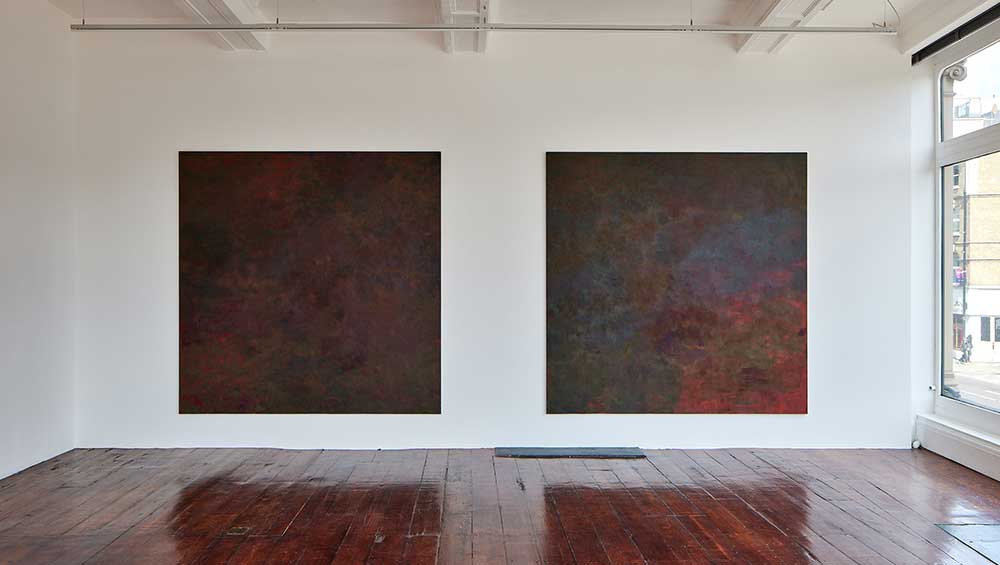
Kate Spencer Stewart: Diurne, installation view, Emalin, London, 6 May - 17 June 2023. Photo: Stephen James.
Emalin, London
6 May – 17 June 2023
by TOM DENMAN
A bird – an American crow, I think – greets you at the Los Angeles-based painter Kate Spencer Stewart’s solo exhibition at Emalin, East London. The print, which appears to be based on a charcoal drawing, features on the invitation, a card you can pick up as you walk in. (When I last looked, it also headlined the show’s website page.) Even if you don’t take the card, this image, which won’t be found in the public part of the gallery, is likely to be the first work of art you come across. And it is likely to stay with you. Lovingly, intimately drawn, the bird is also fading into abstraction. It is as if, as we ascend the staircase to the spacious, naturally lit gallery – since it is May, we can visit only during daylight hours – the bird were somehow becoming increasingly abstract or ethereal, its essence transmuted into the paintings we find there.
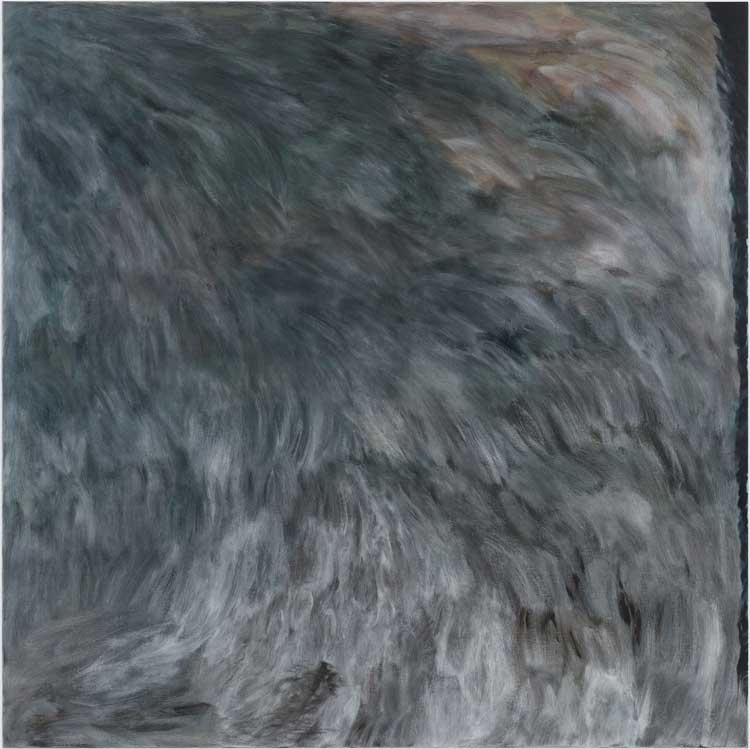
Kate Spencer Stewart, Smith, 2023. Oil on linen, 167.6 x 167.6 x 2.7 cm (66 x 66 x 1 in). Photo: Marten Elder.
At a turning point in the staircase, we pass Smith (all works 2023), itself asymmetrical, turning. The work could be a fragment, withholding our view of the whole. The black, grey and white strokes seem to emerge from somewhere, the top left corner, to be precise, or from a deeper, unseen layer. For a brown, fleshy hue is also detectable, beneath the feathery surface, exposed – or emerging – in a patch in the top right, which highlights the abrupt, black wedge lining the canvas’s right extremity, further suggesting that this was somehow taken from something, that it was a fragment, that it might be representational. At the foot of the canvas, there is a discordant squiggle: a bird’s signature perhaps, or a ruffle? A similar interruption, but more pronounced, occurs at the foot of Baden: a bluish, blackish canvas evocative of the night. But it isn’t necessarily night – as the exhibition title, Diurne (the antonym of the more commonly heard, especially in the field of music, nocturne), suggests. If the painting has a subject, it would be the light breaking through the darkness, or rather that which shines through the gallery’s vast windows, patchily dancing on the surface.
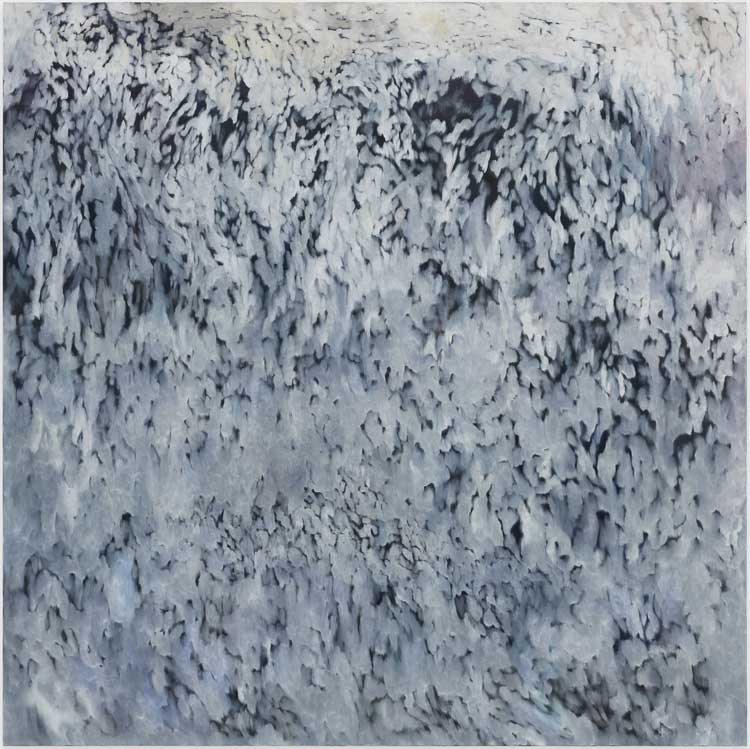
Kate Spencer Stewart, Alphabet, 2023. Oil on linen, 167.6 x 167.6 x 2.7 cm (66 x 66 x 1 in). Photo: Marten Elder.
Alphabet bears close comparison with Smith, not only because of the similar use of black on white, but also because it is teeming with life. However, unlike in Smith, Alphabet’s swarming white forms appear to be pressing against, and eager to overwhelm, the confines of the canvas. And while in Smith the strokes resemble feathers more than anything, in Alphabet the forms are harder to identify. Their resistance to definition and their sense of stirring vibrance together are what make them threatening – it is only natural to be afraid of what moves and we cannot name. To describe them as strokes is not enough, because they are more complex than singular strokes. The elements bundle together and overlap to create definite and yet indefinable lifelike forms, always almost something: almost foam, almost fish, almost sperm, almost homunculi, almost rebel angels, almost souls in purgatory. They rush, they squirm, in schools and individually. The rectangle for the most part contains them, as they appear to search for a way out, and depending on the way the light hits the canvas, they swim through an aperture in the top left corner, or they are about to burst the painting’s banks.
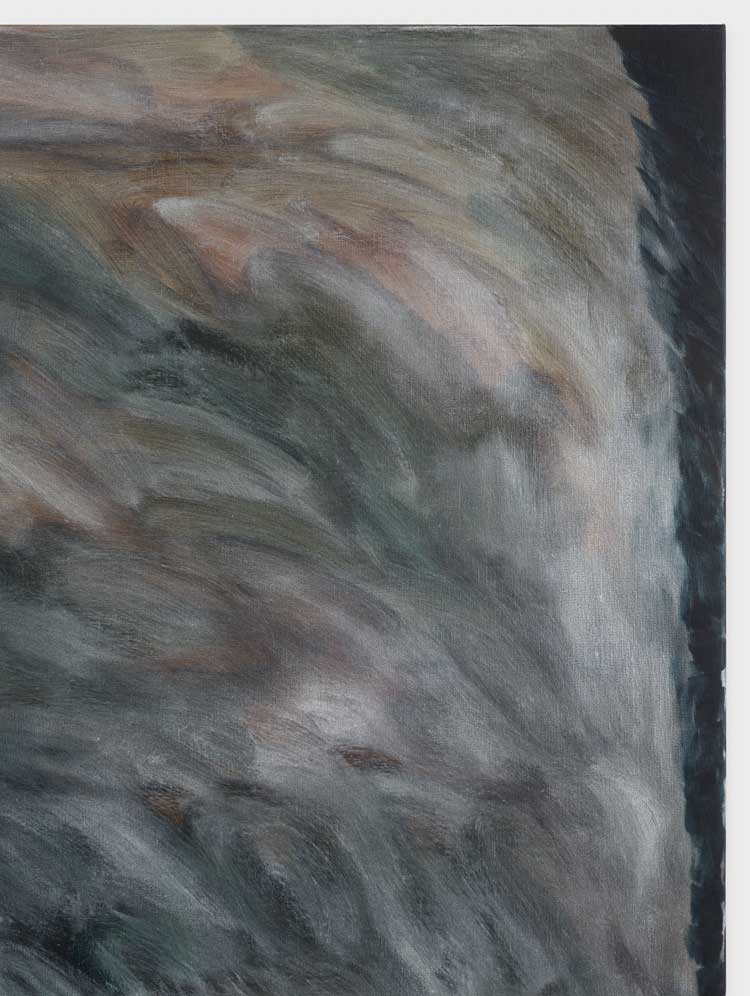
Kate Spencer Stewart, Smith, 2023 (detail). Oil on linen, 167.6 x 167.6 x 2.7 cm (66 x 66 x 1 in). Photo: Marten Elder.
It is hard, impossible even, to justly photograph art, and Stewart’s canvases attest to this fact. It often happens that when I am in a museum, looking at paintings that have been heavily varnished, or those framed behind glass, I need to find an angle from which to avoid the glare and actually see the painting (while trying to not to bump into someone doing exactly the same). Stewart takes into account the contingencies of ambient light in a way no photographic reproduction of a painting can. Like the plumage of an American crow, her works are iridescent, shimmering between hues and moods depending on the moment, and on where you stand. Of course, all paintings, in fact all visible objects, rely on the physics of light for them to have an ocular effect on us, and the variability of this may or may not alter the way seeing them makes us feel. To take a well-known example, variation in how Claude Monet’s waterlilies catch the light is fundamental to their musicality. And yet Stewart is interesting because of the way she distils this fundamental capacity of painting, thereby relinquishing much control to – put simply – the weather.
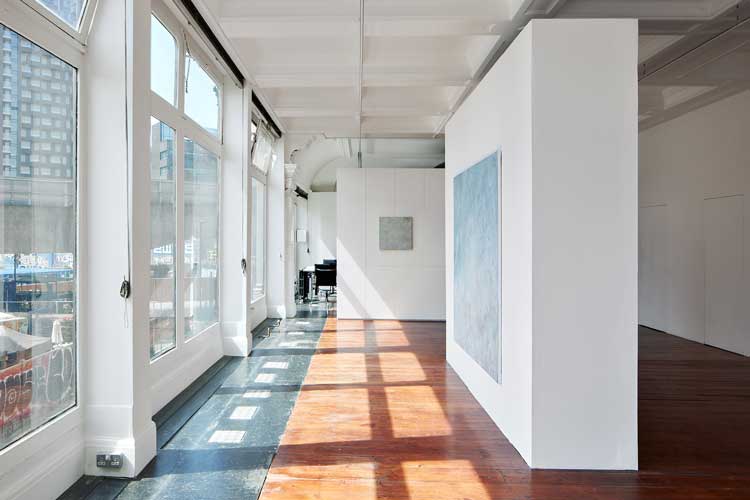
Kate Spencer Stewart: Diurne, installation view, Emalin, London, 6 May - 17 June 2023. Photo: Stephen James.
It was a rainy (Coronation) day when I attended the opening. Emalin, as I have already hinted, boasts an impressive corner of window. If it were hard for the naked eye to pick out any variation in the overcast sky, the paintings responded effectively, and seasonally affectively, to the slightest shift. Someone only needed to pass behind me as I looked at the heavenlike blues and whites in Powdered Wig (2023) for a shadow to brush over its surface, bringing out a grey, portentous dirtiness, and the grooves in the paint, suddenly morphing them from soft caresses to stormy swells. It is the feeling of a dark cloud interrupting a weekend afternoon.
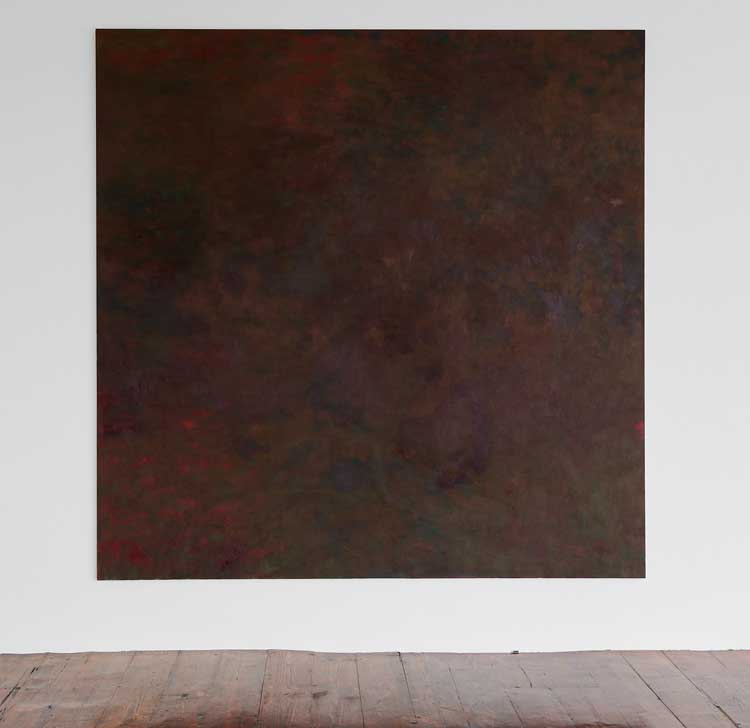
Kate Spencer Stewart, Phthalo Left, 2023. Oil on linen, 213.4 x 213.4 x 2.7 cm (84 x 84 x 1 in). Installation view: Kate Spencer Stewart, Diurne, Emalin, London, 6 May - 17 June 2023. Photo: Stephen James.
In the rusty duo, Phthalo Right and Phthalo Left (both 2023), the opposite happened. At first, and very superficially, the surfaces resemble oxidised steel. Then their painterly sophistication quickly emerges: the layering of strokes, short, measured, spontaneous without being extravagantly so. Browns, reds, greens, ochres. Again, there is a sense that something is being covered up, or that something is being abstracted – that this is not a final abstraction but a process of abstracting and obscuring, happening before us, even if we cannot tell what the original figuration was, or if there was one. And then a rush, a breath, of light: I would not have noticed a momentary, subtle thinning of the atmosphere outside had the painting not. Rosettes of red ripple in from the left, leaving a glare of petroleum blue in their wake.
These effects create intimacy. They bring us closer to the essence of the thing, or the thingness, of what is being obscured, fragmented, blurred; closer to our own bodies, wherein the changes on the canvas are felt. It might also be argued that they are sociable, bringing us closer to each other, by granting us the bodily and emotional presence that is so crucial for meaningful contact to occur. Included in this interaction are the corporal presence of the artist and the flying, feathery spirit of the bird. This is good painting at the level of the short, twisting stroke; painting as and of surface, and of depth and surface again, hypersensitised to its context. Viewing May, the most definably figurative of the works, the white flowers beneath a layer of mottled strokes that mimic them, I think I can hear them reverberating the chatter, and convivial flutter, of the room.
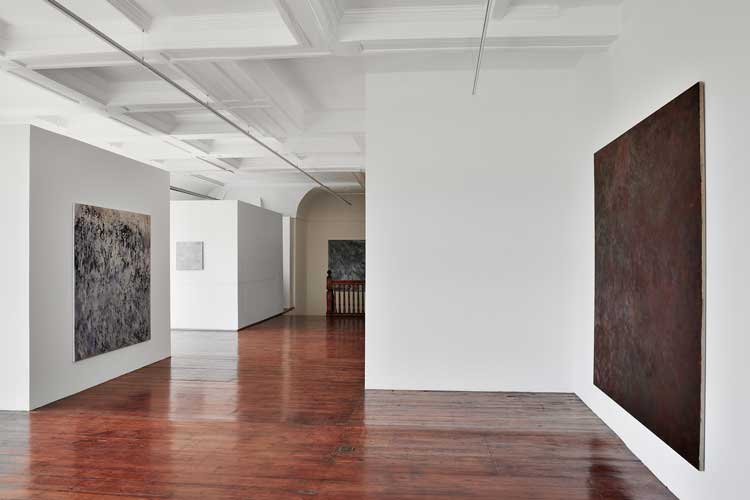
Kate Spencer Stewart: Diurne, installation view, Emalin, London, 6 May - 17 June 2023. Photo: Stephen James.